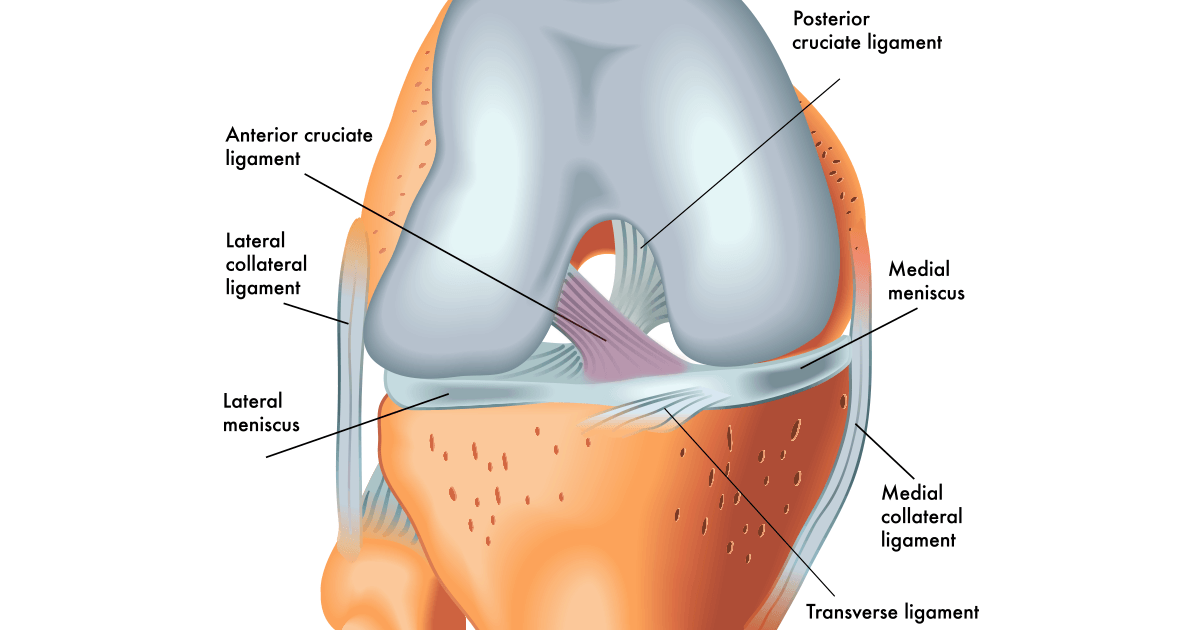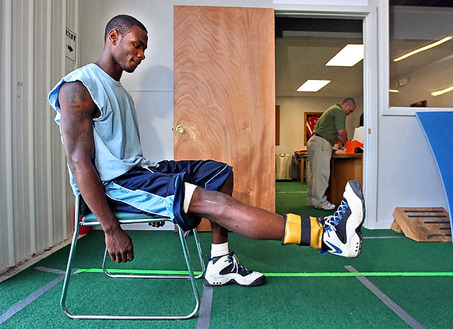
Tearing your ACL (Anterior Cruciate Ligament) can be a traumatic episode or a slow degeneration over time. Either way, there are only two reasonable choices: get an ACL repair surgery or just do Physical Therapy rehab exercises to try to stabilize the injured knee. It’s difficult to have a completely stabilized knee with a full ACL tear, because of what the ACL does within the knee joint.
The ACL is one of four major ligaments in the knee joint. The other three are the MCL (Medial Collateral Ligament), the LCL (Lateral Collateral Ligament), and the PCL (Posterior Collateral Ligament). The ACL is a strong ligament that prevents anterior translation of the tibia on the femur. In other words, when you squat or bend your knee in a closed-chain position (foot on the ground), the ACL prevents or limits the lower leg from moving forward.
Knee ligaments are usually torn by severe forces caused by extreme and rapid bending of the knee. Since ligaments are strong bands of soft tissue that attach one bone to another, tearing a major ligament is usually very painful and elicits a “popping” sensation. Occasionally, the ACL can just degrade gradually over time, perhaps occurring with several small accidents or injuries. People with a deficient ACL feel tremendous instability with squatting, lunging, jumping, and quick change of direction exercises. ACL tears are more common in high contact sports such as football and rugby, in which awkward hits and movements occur. Sports with a rapid change of direction such as basketball and soccer also have a higher than normal occurrence rate for ACL tears. Auto accidents, slip and falls, and jumping awkwardly can all cause the ACL to tear.
Diagnosis
The best way to diagnose an ACL tear is by using either the Anterior Drawer Test or the Lachman’s Test. These tests help the provider to evaluate the amount of anterior translation of the tibia on the femur. A positive test occurs when there is hyper-mobility of the tibia greater than a normal amount of joint play in the knee. If there is no definitive end-feel during these tests, then a full ACL tear is highly likely. Of course, an MRI will need to be performed to fully confirm the diagnosis.
Once the diagnosis has been confirmed, the patient has to decide whether to get a surgical reconstruction or just do Physical Therapy rehab to learn how to deal with it. If surgery is opted for, it usually performed in one of two different ways. The first and most common way of replacing the torn ligament is to use the ACL from a cadaver body, and implant this ACL where the old one was attached inside the knee. The second way to do this repair is to graft a pseudo ACL off one of the patient’s hamstring tendons and attach it inside the knee.
Rehab
If the surgery goes well, then the patient will usually begin Physical Therapy within the first week, so that the joint doesn’t become stiff. Sometimes, the surgeon will order Home Physical Therapy for the first 2-3 weeks after the surgery, because it’s so much easier for the patient. Each Orthopedic Surgeon typically has their ACL post-op protocol, and some surgeons have a few or several different protocols, depending on the complexity of the surgery and the patient’s age and physical conditioning level. For example, a 20-year-old professional athlete will be on a faster protocol than a sedentary 50-year-old, that never plays sports or exercises. Although a protocol may be important, it’s also up to them to Physical Therapy provider to decide if the patient is ahead or behind where they are supposed to be and adjust the exercise routine accordingly. Providers have to remember that each individual is different, and the road to health is paved with ups and downs. With time, good medical care, and personalized Physical Therapy, patients can expect to minimize their healing time significantly.
The basic post-op exercise protocol following ACL reconstruction typically is drafted for a 6-9 month time frame. Physical Therapy usually lasts anywhere from 3 months up to 9 months, depending on patient motivation, complications, and need to regain the previous level of function. Sometimes patients can continue to do the exercises on their own, once they get to a good level in the clinic. Week 1 therapeutic exercises may include Quad Sets, Straight Leg Raises, Hip exercises, Hamstrings Stretches, and Heel Slides. Eventually, the patient will be able to perform Squats, Lunges, Deadlifts, Knee Extensions, Plyometrics, and eventually Running and Agility Drills.
The rehab exercises for patients choosing not to get surgery are similar to the ACL reconstruction post-op exercises, except instead of starting at week 1, the ACL deficient patient would incorporate some early exercises and also perform many closed chain exercises to work on knee stability. Squats, Lunges, Deadlifts, and Balancing exercises can be utilized immediately, as long as the patient doesn’t have too much pain or inflammation left over from the initial trauma of the ACL tear.
Long Term Prognosis
Although it seems unlikely that ACL deficient patients can get back to playing sports at a high level, it is possible to develop surrounding muscles to compensate for the torn ACL. Also, wearing an ACL brace during sports activities helps with stability for both the ACL deficient and post-op patient. The choice of whether to get the ACL reconstruction surgery or not can only be made by the patient. Ultimately, Physical Therapy rehab exercises are recommended either way, but it is possible to regain a fairly good amount of function without going through the surgery and the difficult rehab. But typically, if the patient wants to resume playing sports or activities at their prior level before the injury, then the surgery is strongly recommended.
For more info visit: www.cardioflextherapy.com

